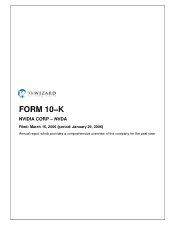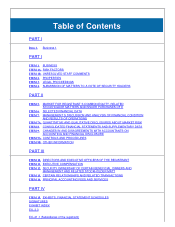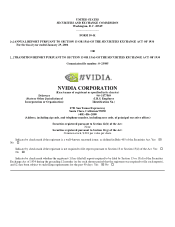NVIDIA 2006 Annual Report Download - page 9
Download and view the complete annual report
Please find page 9 of the 2006 NVIDIA annual report below. You can navigate through the pages in the report by either clicking on the pages listed below, or by using the keyword search tool below to find specific information within the annual report.
MCP Business
The NVIDIA nForce family of products represents our MCPs for Advanced Micro Devices, Inc., or AMD, and Intel Corporation,
or Intel,−based desktop, notebook, professional workstations and servers. Our strategy for MCPs aligns with what we anticipate will
drive growth such as multi−core, ever−increasing−speed networking and storage technologies, and integration of complex features
such as virtualization, security processing, network processing and more. The In−Stat Trendy Chipset for the x86 Processor Report
projects strong growth for PC chipsets through the end of this decade: from $7.6 billion in 2006 to over $10 billion in 2009. In
September 2005, we introduced our first integrated graphics core logic solutions in more than two years, the GeForce 6100 Series
GPU and NVIDIA nForce 400 Series MCP. We offer the industry's first and only integrated core logic to feature DirectX 9.0 and
Shader Model 3.0 technology. We also offer PureVideo technology, a HD video processor designed to deliver a home theater−quality
movie watching experience on PCs and media centers. NVIDIA is now the third largest core logic supplier in the world, according to
the Mercury Research Fourth Quarter 2005 PC Graphics Report. We are the largest supplier of AMD 64 chipsets with 38% segment
share. NVIDIA nForce MCP unit shipments for AMD64−based CPUs increased over 510% year−over year, based on the Mercury
Research Fourth Quarter 2005 PC Processor Forecast Report.
Handheld GPU Business
Our strategy in our Handheld GPU Business is to lead innovation and capitalize on the emergence of the cellular phone as a
versatile consumer lifestyle device. The hallmark of every device in the NVIDIA GoForce product family is to provide a
high−performance, visually rich multimedia experience on cellular phones and handheld devices. These products deliver an advanced
visual experience by accelerating graphics and video applications, and supporting the most demanded features and capabilities.
GoForce handheld GPUs implement innovative design techniques, both inside the chips and at the system level, which result in high
performance and long battery life. These technologies enhance visual display capabilities, improve connectivity, and minimize chip
and system−level power consumption. GoForce products can be found in advanced multimedia cellular phones, PDAs, and other
handheld devices.
Consumer Electronics Business
Our Consumer Electronics Business is composed of our contractual arrangements with SCE to jointly develop a custom GPU
incorporating our next−generation GeForce GPU and SCE's system solutions in SCE's PlayStation3, sales of our Xbox−related
products, revenue from our license agreement with Microsoft relating to the successor product to their initial Xbox gaming console,
the Xbox360, and related devices, and digital media processor products. During the first quarter of fiscal 2006, Microsoft indicated
that it would not order any more Xbox−related products from us after our second fiscal quarter. As a result, the second quarter of
fiscal 2006 was the last quarter during which we recognized revenue from the sale of our Xbox−related products to Microsoft.
Our Products
We have four major product groups: GPUs, MCPs, Handheld GPUs, and Consumer Electronics. Each of our product lines is
designed to provide the advanced processing of a combination of graphics, HD video, audio, communications, network security and
storage. Our products are designed to support and deliver the maximum performance for the most current standards as determined by
each industry segment, and to provide a comprehensive set of features that enhance the overall operation and compatibility of each
platform they support.
GPUs. Our GPU products support desktop PCs, notebook PCs and professional workstations. We have three major families of
GPUs: GeForce, Go and NVIDIA Quadro.
GeForce. The GeForce family represents our desktop GPUs and includes the GeForce7, GeForce 6, GeForce FX and GeForce4
families. In March 2005, we introduced two new GeForce 6 GPUs: a 512MB version of the GeForce 6800 Ultra designed for the
enthusiast segment, and a new lower−cost AGP version of the GeForce 6200 GPU, designed to bring DirectX 9.0 Shader Model 3.0
technology to the mainstream segment. Our most advanced GPU family is the
3






















